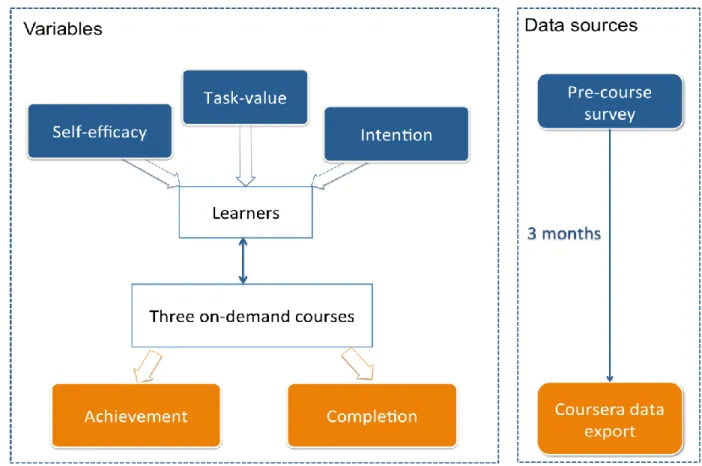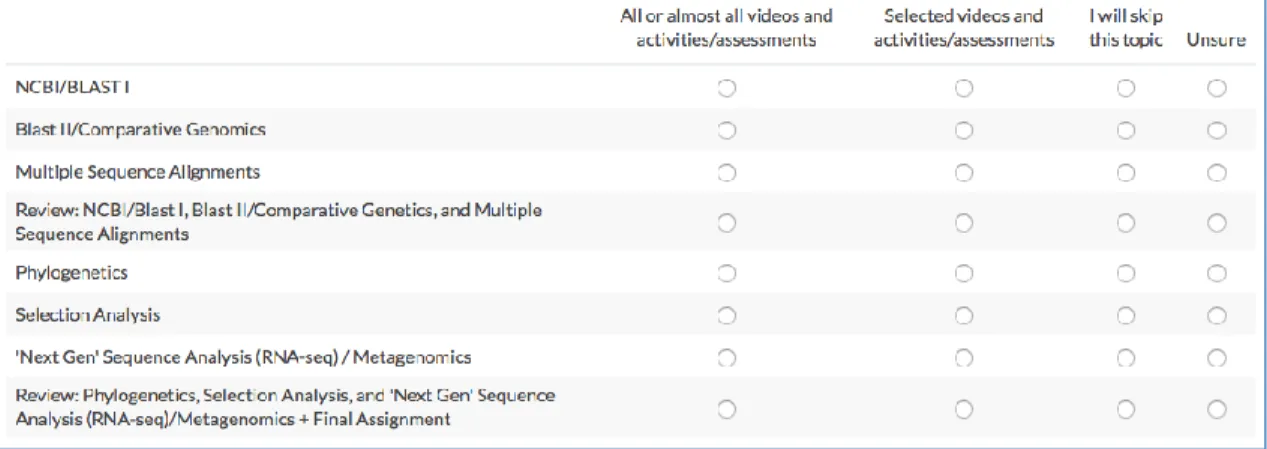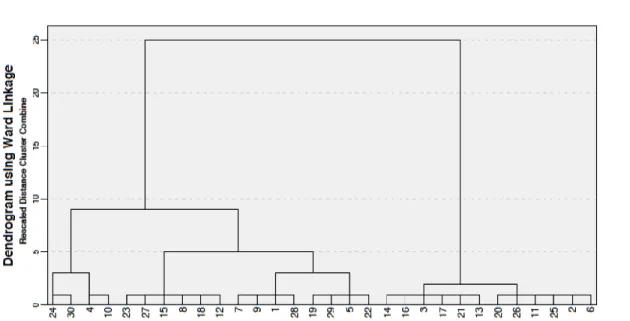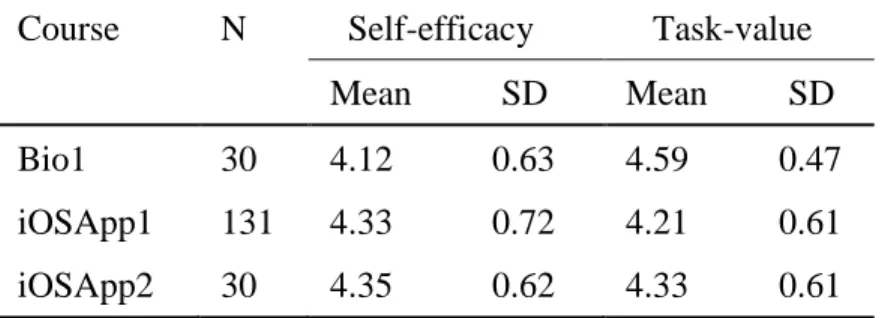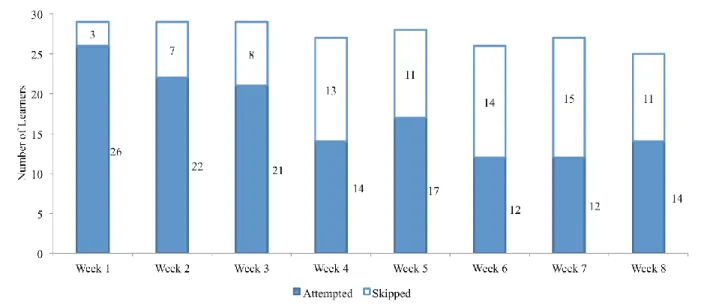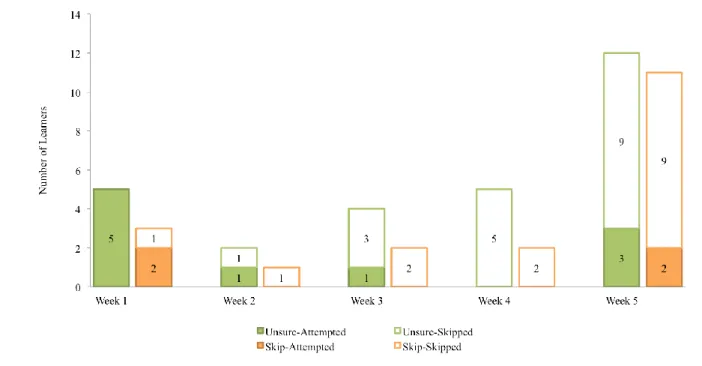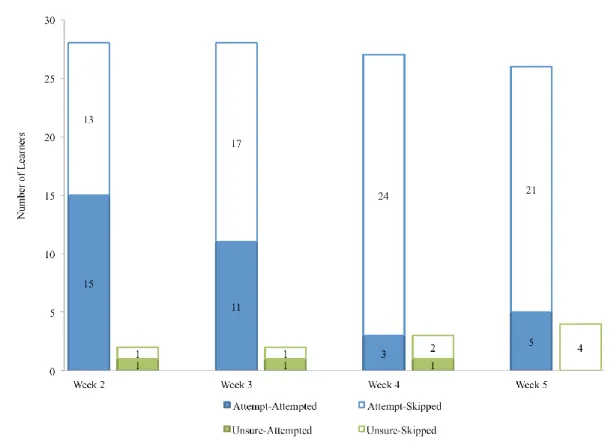Volume 44(2)
Summer/été 2018
Connecting Learner Motivation to Learner Progress and Completion in
Massive Open Online Courses
Relier la motivation de l’apprenant à ses progrès et à l’achèvement des cours
en ligne ouverts à tous
Hedieh Najafi, University of Toronto Carol Rolheiser, University of Toronto Laurie Harrison, University of Toronto Will Heikoop, University of Toronto
Abstract
We examined how massive open online courses (MOOC) learners’ motivational factors, self-efficacy, and task-value related to their course progress and achievement, as informed by learners’ initial course completion intention. In three individual MOOCs, learners completed a pre-course survey to report their levels of task-value and self-efficacy and to indicate their intention to complete each course topic. Using clustering techniques, we identified two distinct groups of learners in the three MOOCs based on self-efficacy and task-value variables: higher-motivation group and lower-higher-motivation group. The higher-higher-motivation group achieved
significantly higher grades in two of the MOOCs, and also adhered to their initial completion intention significantly more so than the lower-motivation group. We posit that MOOC completion research should consider learners’ topic-level interest as one success criterion. Further research can clarify perceived task-value in relation to learners’ existing knowledge, their learning goals, and learning outcomes related to the MOOC participation.
Résumé
Nous avons examiné comment, dans les cours en ligne ouverts à tous (CLOT), les
facteurs de motivation des apprenants, leur autoefficacité et leur valeur tâche étaient reliés à leurs progrès et à leur achèvement du cours selon l’intention initiale d’achèvement du cours des
apprenants. Dans trois CLOT, les apprenants ont rempli un sondage avant le début du cours pour indiquer leur degré de valeur tâche et d’autoefficacité, ainsi que leur intention de compléter chaque sujet du cours. À l’aide de techniques agglomératives, nous avons cerné deux groupes distincts d’apprenants dans trois CLOT selon les variables de la valeur tâche et de
élevées dans deux CLOT et, dans deux cours, ont adhéré à leur intention initiale d’achèvement considérablement plus que le groupe dont la motivation était moindre. Nous posons en principe que la recherche sur l’achèvement des CLOT devrait tenir compte de l’intérêt des apprenants sur le plan des sujets comme étant un critère de réussite. De plus amples recherches pourraient clarifier la valeur tâche perçue relativement aux connaissances préalables des apprenants, à leurs objectifs d’apprentissage et aux résultats d’apprentissage liés à la participation aux CLOT.
Introduction
Research into understanding learner behaviour in MOOCs has led to studies that create profiles of learners based on their engagement with course components and their completion trajectories (Kizilcec, Piech, & Schneider, 2013). MOOC learners’ intentions for enrolling in such courses and the learners’ projected overall completion goals have also been considered in previous research in relation to the learners’ actual course completion (Pursel, Zhang, Jablokow, Choi, & Velegol, 2016). Another body of research, however, investigates learner experience in online self-paced courses that are not labelled as MOOCs. These studies consider learner motivation within a social cognitive framework (Schunk & Usher, 2012) to understand if and how motivational factors explain learners’ performance and experience in such online self-paced environments.
We studied the relation between learners’ motivation and completion goals with learners’ outcome in three on-demand Coursera MOOCs. Learner motivational characteristics included task-value and self-efficacy. Intended completion goals indicated initial intention to complete all or parts of the courses. Measures of learning outcome were learner achievement in terms of final course grade, and learner progress in terms of partial or full completion of course components. On-demand MOOCs are offered multiple times and allow the learners to choose a start date that best suits their schedule. Learners can resume their study with upcoming cohorts if they do not accomplish their intended completion threshold in one course offering. Similar to self-paced online courses, learners enrol in on-demand MOOCs to achieve personal, academic, or professional goals (Kim, Allbritton, Keri, Mieyal, & Wilson-Delfosse, 2015).
Related Literature
Existing literature suggests students’ achievement in self-paced online courses is
comparable to the achievement of students in instructor-led online or face-to-face course delivery modes (Kim et al., 2015; Russell, Kleiman, Carey, & Douglas, 2009; Southard, Meddaugh, & France-Harris, 2015). Low completion rate, however, is a recurring concern in online courses, including MOOCs (Kim et al., 2015; Watson, Kim, & Watson, 2016).
Learner Motivation in Self-Paced Online Courses
Research in online learning contexts suggests a relationship between learner motivation and learner achievement (Hart, 2012). In paced online courses, task-value and learner self-efficacy are two motivational factors (Pintrich, 1999) recognized to impact student learning.
Heron, 2015) where final course grades positively correlated with task-value and self-efficacy. Results showed that learners who completed the course had 61.57% higher levels of task-value and self-efficacy in comparison to learners who did not pass.
In a study of task-value as another impacting factor, self-efficacy was not a significant predictor of learner achievement. To probe the impact of learner motivation on completion, Pachlhofer and Vander Putten (2014) surveyed 274 learners in a self-paced mathematics course using five subscales: intrinsic goal orientation, extrinsic goal orientation, task-value, control of learning beliefs, and self-efficacy. While the regression model was not significant, the
researchers found task-value, not self-efficacy, as a significant predictor of course completion. Motivation, Intention, and Achievement in MOOCs
Learner motivation and intention and its relation to learner achievement have been also measured in MOOCs. Learner motivation can refer to social cognitive measures of motivation (Schunk & Usher 2012). One example of that interpretation is Littlejohn, Hood, Milligan, and Mustain’s (2016) study of self-regulation in a data science MOOC. Learner motivation can also explain learners’ personal or professional reasons for enrolling in a MOOC, often measured by the online learning enrollment intention instrument (Kizilcec & Schneider, 2015; Pursel et al., 2016). This latter interpretation is informed by studies that characterize learner motivation in relation to the degree that available online resources match self-identified personal and
professional needs (Kizilcec & Schneider, 2015). These two interpretations of learner motivation can complement each other. In two MOOCs geared towards professionals (Milligan &
Littlejohn, 2017), in addition to a survey that contained motivation measures such as task-value and self-efficacy, an open-ended question probed learners’ self-identified motivations for their course enrollment. A thematic analysis of 970 responses led to similar categories of motivation as present in the online learning enrollment intention scale.
Measures of completion intention mostly reflect learners’ initial self-reported intention of obtaining a statement of course completion or engaging with a certain overall proportion of course content and course assessment components. For example, learners in four different MOOCs (two programming, one statistics, and one human physiology) indicated their course completion intention by choosing one of the following four options: all, most, some, or none of the course components (Campbell, Gibbs, Najafi, & Severinsky, 2014; Engle, Mankoff, & Carbrey, 2015).
In a social science MOOC, a logistic regression analysis pre-course survey of
respondents showed that intended participation level and personal goals for completing course components predicted performance as measured by completion status and the results of course assessments (Pursel et al., 2016). Motivation measures in Pursel et al.'s (2016) study included learners’ reasons for enrolling in the course and their intention to choose one of the two completion tracks offered in the course.
Instances of topic-level initial completion intention are rare in the MOOC literature. To examine the relationship between learner completion intentions and their course progress in the Mapping with Google MOOC, learners chose from a list of mutually exclusive intention options
course or obtain a certificate for two broad course topics. This pre-course survey revealed that 44.7% of survey responders did not intend to receive a certificate. A follow up clickstream analysis of learner behaviour indicated that 42.4% of learners actually achieved or exceeded their initial completion goal.
The emphasis on course completion and identifying ways to extend learners' persistence to complete MOOC-like courses is a significant goal that guides designing interventions to prevent dropouts when possible (Crossley, Paquette, Dascalu, McNamara, & Baker, 2016; Robinson, Yeomans, Reich, Hulleman, & Gehlbach, 2016).
Significance of the Study and Research Questions
While the social cognitive framework of self-regulated learning informed the majority of studies that we reviewed here, MOOC research studies are only beginning to consider the impact of motivation on learners’ experience in this distinct form of self-paced online learning. Thus, in the context of on-demand MOOCs, we considered the relation of two motivation factors, self-efficacy and task-value, with learners’ achievement and course progress using a person-oriented design (von Eye & Bogat, 2006).
Refining measures of learner completion was another objective of our study. As discussed above, intention to complete self-paced courses is often assumed (Gerlich, Mills, & Sollosy, 2009) with course completion being a major metric for learner achievement in self-paced on-demand courses and in MOOCs (Pursel et al., 2016). In this study, we expanded the concept of course completion by inquiring into learners’ intention to complete course
components at weekly/module levels. Combining learner progress data, available through MOOC providers, with their learner intention, would allow us to understand if learners achieved their desired level of completion. In the studies that we reviewed here, learner progress data were rarely used in conjunction with learner intent for course completion. Two research questions guided our study:
• How are learner motivational characteristics related to learner achievement? • How are learner motivational characteristics related to learner actual completion?
Methods Context
Three on-demand Coursera courses were chosen as convenience cases (Saumure & Given, 2008) for this study: Bioinformatic Methods 1 (Bio1); Introduction to Swift Programming (iOSApp1); and iOS App Development Basics (iOSApp2). Below, we briefly describe each course:
• Bio1 has eight modules with content presented through mini lectures, lab lectures, and summary videos. Assessment includes weekly quizzes, two sectional quizzes, and one course assignment, which were all multiple-choice questions. To pass the course, learners should minimally obtain 80% in each assessment.
• iOSApp1 and iOSApp2 belong to the Coursera iOS App Development with Swift Specialization and are each five weeks long. In the first four weeks, learners watch lecture videos, submit quizzes, install needed software, access further readings, and use the discussion forum. Assessment in both courses consists of weekly multiple-choice questions that can be re-submitted three times with an eight-hour interval between submissions. The final project in iOSApp1 and iOSApp2 constitute 40% of the total grade. To complete the course, learners need to achieve 70% on all quizzes and the course project.
Participants
Learners who had registered in Bio1, iOSApp1, or iOSApp2 courses between March 18, 2016 and July 30, 2016 were considered as study participants. To maintain the anonymity of potential participants, we used Coursera's built-in announcement functionality to inform the registrants about voluntary pre-course questionnaires.
Materials
Figure 1 depicts study design, including variables, data collection methods, and study timeline. Learner data were completely anonymous to the researchers.
We used three main sources of data:
1. Learner motivational characteristics. A pre-course survey, sent to learners via course email announcements, collected learner-reported data on self-efficacy, task-value, and intended completion. For motivational characteristics, we adapted five items for task-value (six items for iOSApp2) and five items for self-efficacy subscales from the online learning value and self-efficacy scale self-assessment instrument developed by Artino and McCoach (2008) with a 5-point Likert scale ranging from “Very true for me” to “Not true at all for me”. A sample item for self-efficacy was “I believe I will receive an excellent grade in this class”. A sample item for task-value was “Completing this course moves me closer to attaining my career goals”
2. Learner completion intention. The pre-course survey also asked learners to indicate their likeliness to complete each week of the course on a 4-point scale: “All or almost all of videos and activities/assessments”, “Selected videos and activities/assessments”, “I will skip this topic”, and “Unsure”. The completion intention items for each course reflected weekly topics and assessments. Figure 2 shows learner completion intention items for the Bio1 course. In these three courses, a single weekly grade point was recorded for each learner, and learners had to complete all weekly questions to pass the assessment component of that week. As the analysis that we present in this paper focused on assessment data, we combined two options of “All/Almost all” and “Selected” into “All” for data collected in the completion intention section of the pre-course survey.
Figure 2. Completion intention items for Bio1.
3. Learner achievement and learner progress data. A data specialist exported learner progress and achievement data from Coursera and matched them with survey responses. Measures of course progress were recorded from grades on quizzes, assignments, and
projects that a learner attempted within the timeline of this study. Another measure of course progress was whether a learner attempted an assessment component regardless of the points they acquired in that assessment component. Achievement represented a learner’s final course grade. Passing status was a dichotomous variable showing if the learner obtained the minimum grade for passing the course.
Procedure
Starting March 18, 2016, a data specialist sent bi-weekly course announcements, three announcements for each course, to invite enrolled learners to complete the pre-course survey. Learner data from Coursera was extracted at the end of July 2016. We allowed three months between pre-course surveys and data extraction from Coursera to maximize course completion. We made this choice at the study design stage of this research informed by statistics provided by Coursera on the likeliness of learners to complete a course within 90 days of enrollment.
With communication restraints in Coursera, we could only estimate the number of learners who received the invitation to complete the pre-course survey as 4,186 learners in iOSApp1, 2,049 learners in Bio1, and 1,123 learners in iOSApp2. Response rates for each course was: 131 learners in iOSApp1, 30 learners in iOSApp2, and finally 30 learners in Bio1.
Analysis
First, we ran descriptive statistics using SPSS V. 20 to depict the distribution of learner motivational characteristics in the three courses and to summarize learners’ weekly completion intention. We adopted a person-oriented analysis approach (von Eye & Bogat, 2006) to
understand learner behaviour in light of a learner motivational profile. We conducted exploratory cluster analyses (Csizér & Jamieson, 2012) in each course using self-efficacy and task-value as clustering variables. Each resulting group in cluster analysis showcases learners who present similar compound motivational characteristics within their group and are distinguishable from members of other groups based on the compound motivational characteristics levels. Satisfying assumptions for cluster analysis is contested. Recommendations exist to follow similar
assumptions as multivariate statistical models when conducting cluster analysis (Hair, Black, Babin, Anderson, & Tatham, 1998). Conversely, other authors suggest that cluster analysis does not require satisfying such assumptions (Milligan, 1996; Norušis, 2012).
Next, we conducted hierarchical cluster analysis using Ward method to determine the number of learner clusters. Using the resulting agglomeration table and dendrogram, it is possible to discern the number of clusters with distinct compound levels of the clustering variables. As shown in the dendrogram of Bio1 in Figure 3, the largest distance between stages when creating cluster solutions occurred when learners are grouped into two clusters. This cluster analysis for iOSApp1 and iOSApp2 courses also suggested two clusters of learners.
Figure 3. Dendrogram using Ward linkage for Bio1.
Then, we conducted k-means clustering for each course to place learners in two learner profiles. Figure 4 demonstrates the number of learners in each cluster for Bio1. In Figure 4, learners in Cluster 1 show overall lower levels of self-efficacy and task-value compared to learners in Cluster 2. We labelled Cluster 1 as “lower-motivation” learners and Cluster 2 as “higher-motivation” learners. Similar clusters resulted for iOSApp 1 and iOSApp2. In each MOOC learners were placed either in a lower-motivation learner profile or a higher-motivation learner profile.
Once learner profiles were created, we calculated the difference between achievement and completion means with learner profiles as the independent variable and course achievement and course completion as the dependent variables.
Findings
We present the findings of the study in the following order: intended versus actual completion of the courses, differences between learner profiles with regards to overall course achievement, and differences between learner profiles with regards to intended course
completion.
We calculated Cronbach’s alpha for the composite of items for self-efficacy and task-value (Table 1). We observed high reliability of pre-course survey items in all three courses (.76 < α < .92). We used the average of the items to represent self-efficacy and task-value measures for learners.
Table 1
Cronbach’s Alpha for Self-Efficacy and Task-Value Subscales
Course Task-value Self-efficacy
Bio1 .76 .84
iOSApp1 .76 .89 iOSApp2 .79 .81
Descriptive Statistics
Table 2 shows descriptive statistics for self-efficacy and task-value variables. Across all courses, the mean values of both variables were above the midpoint of the 5-point Likert scale. Survey respondents deemed the course relevant to their goals and also were confident that they could successfully finish the course.
Table 2
Descriptive Statistics, Self-Efficacy, and Task-Value Variables
Course N Self-efficacy Task-value Mean SD Mean SD Bio1 30 4.12 0.63 4.59 0.47 iOSApp1 131 4.33 0.72 4.21 0.61 iOSApp2 30 4.35 0.62 4.33 0.61
To present a more granular view of learner achievement in these courses, we calculated the average final course grade for each course. As the “Course Grade” column of Table 3 shows, the mean course grade in all courses was below 50%. We distinguished between learners who did not attempt any course assessment and those who scored below the passing threshold. While establishing a consistent pattern was not possible, we observed that at least 34% of the learners in the three courses attempted some of the course assessments. Also, more learners in Bio1 passed the course compared to learners in the two programming courses.
Table 3
Learners’ Achievement as Final Course Grade in the Three MOOCs
Course N Course Grade Not Passed Passed
Mean SD Below threshold Skipped
Bio1 30 47.93 45.36 34.37% 21.87% 43.80%
iOSApp1 131 40.69 34.63 64.39% 17.42% 18.20%
iOSApp2 30 27.70 35.48 36.67% 46.67% 16.70%
Learners had indicated their likeliness to complete each week of the three courses in the pre-course survey. Table 4 demonstrates the average proportion of learners in each MOOC across all weeks that selected one of the three intention levels of “Attempt all”, “Unsure”, or “Skip” and their initial intention.
Table 4
Average Completion Intentions in the Three MOOCs
Course N Attempt All Unsure Skip
Bio1 30 92.58% 7.42% .87%
iOSApp1 131 92.87% 4.24% 2.87%
iOSApp2 30 90.83% 9.16% -
The majority of learners in each course, at least 90%, intended to complete all of the assessment components of the courses. However, there were learners who intended to skip certain weekly assessments. Below, we provide more detail on students’ initial intention and their actual completion of the weekly assessment components in each course.
Course Progress Informed by Completion Intention
Using Coursera’s learner progress data, we examined if the learner attempted or skipped the assessment for different weeks of a course and then compared the action with the learner’s initial completion intent. Here, we provide a descriptive summary of intended versus actual weekly completion for each course.
Bio1. As demonstrated in Table 4, on average at least 92% of learners in this course who completed the pre-course survey indicated their intention to complete all assessment
components. Only one learner intended to skip week 7 and week 8. Coursera learner data showed that this learner attempted the assessment in week 7 but skipped week 8. For learners whose initial intention was to complete all assessments, Figure 5 shows their actual progress in the course. While at least 72.4% of the learners who intended to complete all assessments did so in the first three weeks of the course, the last three weeks of the course shows a decline in
achieving such completion goal ranging between 44.4% and 56.0%.
Figure 5. Actual versus intended completion for Bio1 learners with “Will attempt” initial
intention.
Learners who were initially unsure about completing weekly assessments skipped the assessments in four weeks out of eight weeks of Bio1. The number of learners in the “Unsure” category was one in week 1, week 2, and week 3 and two for week 5. All these learners skipped the assessments. In week 4, week 6, week 7, and week 8, where three, four, two, and four learners had selected the “Unsure” intention respectively, only one learner actually completed the assessments.
iOSApp1. Of the 131 learners in the iOSApp1 course, between 108 and 128 learners indicated a “Will attempt” initial intention for weekly assessments. As illustrated in Table 5, however, in the last two weeks of the course only 63 out of 124 in week 4 and 50 out of 108 in week 5 actually completed the assessments.
Table 5
Actual versus Intended Completion for iOSApp1 Learners with “Will attempt” Initial Intention
Number of learners Number of learners attempted Number of learners skipped Week 1 123 104 19 Week 2 128 81 47 Week 3 125 72 53 Week 4 124 63 61 Week 5 108 50 58
Learners in iOSApp1 who were unsure about completing assessments in week 2 to week 5 or intended to skip the assessments in those weeks generally skipped them. As Figure 6 shows, from a total of eight iOSApp1 learners with “Unsure” or “Skip” intention for week 1, seven of them decided to attempt the assessment. iOSApp1 had the largest number of learners who had decided to skip assessments in some of the weeks. Specifically, 11 learners indicated in the pre-course survey that they would skip the final pre-course project in week 5. Course progress data showed that nine learners in this group skipped the assessment as planned and two of them attempted the final course project.
Figure 6. Actual versus intended completion for iOSApp1 learners with “Unsure” and “Will
skip” initial intentions.
iOSApp2. None of the 30 learners in iOSApp2 who responded to the pre-course survey intended to skip any weekly assessments. Yet compared to Bio1 and iOSApp1, learners in
40% of learners who intended to attempt the assessments skipped them. The highest proportion of “Will attempt/Skipped”, 88.88%, in iOSApp2 was in week 4. A considerable proportion of learners who intended to complete the course or some of its components did not maintain their initial intent.
Figure 7. Actual vs. indented completion for iOSApp2 learners with “Will attempt” and
“Unsure” initial intention.
Next, we explain how we used self-reported motivational characteristics to identify learner profiles and to investigate differences between achievement and completion among these learner profiles.
Learner Achievement across Motivation Profiles
The clustering process that we explained in the methods section yielded two distinct motivational profiles in Bio1, iOSApp1, and iOSApp2. As the final cluster centres diagram in Figure 4 illustrates, one cluster showed lower levels for self-efficacy and task-value variables. Accordingly, we labelled the learner profiles as lower-motivation and higher-motivation.
Using an independent-samples t-test, we compared the mean scores of course grades for the two learner motivation profiles in Bio1, iOSApp1, and iOSApp2 MOOCs (see Table 6). In Bio1, the higher-motivation group (M=67.68, SD=42.79, N=14) obtained significantly higher course grades than the lower-motivation group (M=24.49, SD=37.30, N=16); t(28)=2.95, p=.006, two-tailed. The higher-motivation group (M=48.59, SD=34.34, N=82) in iOSApp1 also
t(129)=3.42, p=.001, two-tailed. In iOSApp2, however, while the higher-motivation group
(M=28.92, SD=31.20, N=25) scored higher compared to the lower-motivation group (M=21.61,
SD=40.47, N=5), the difference was not significant, t(28)=.41, p=.682, two-tailed.
Table 6
Achievement as final course grade in two learner profiles
Course Higher-Motivation Lower-Motivation t-test (df)
N Mean SD N Mean SD
Bio1 14 67.68 42.79 16 24.49 37.30 2.95* (28) iOSApp1 82 48.59 34.34 49 27.99 31.59 3.42* (129) iOSApp2 25 28.92 31.20 5 21.61 40.47 0.41 (28) * p < .05
iOSApp2 presents an interesting case as the average course grade for higher-motivation learners, M=28.92, is the lowest compared to higher-motivation learners in Bio1, M= 67.68, and iOSApp1, M= 48.59. Earlier in the findings section, we provided an average score for the two variables of task-value and self-efficacy in the three courses. At M=4.33, learners in the iOSApp2 course had a comparable task-value score to the other two courses, and their self-efficacy score with a mean of M=4.35 was the highest compared to the other three courses. Considered together, we posit that high initial motivational values can only partially explain learners’ achievement in a course. We were unable to measure several other possible contextual factors, such as the impact of the specific course design considerations or learners’ background knowledge.
Learner Completion Across Motivation Profiles
We followed-up learner achievement findings with a more in-depth analysis of whether higher-motivation learners and lower-motivation learners differed with respect to obtaining their intended completion goals.
For this purpose, we calculated a completion index for each learner as the average of weekly completion indices. For each week, a learner received a weekly completion index of 1 if they obtained their intention, or 0 if they did not obtain their initial intention. The completion index ranged between 0 and 1. The results of two-tailed independent sample t-tests to compare the completion index of higher-motivation and lower-motivation learners in Bio1, iOSApp1, and iOSApp2 is presented in Table 7.
Table 7
Completion versus Intention in Two Learner Profiles
Course Higher-Motivation Lower-Motivation t-test (df)
N Mean SD N Mean SD
Bio1 14 0.80 0.34 16 0.42 0.36 2.95* (28) iOSApp1 82 0.68 0.36 49 0.48 0.40 2.99* (129) iOSApp2 25 0.31 0.33 5 0.30 0.41 0.06 (28) * p < .05
Higher-motivation learners in Bio1 (M=0.80, SD=0.34, N=14) and iOSApp1 (M=0.68,
SD=0.36, N=82) obtained significantly higher (p < .05) Completion Indices compared to
lower-motivation learners in Bio1 (M=0.42, SD=0.36, N=16) and iOSApp1 (M=0.48, SD=0.40, N=49), respectively. We posit that in Bio1 and iOSApp1 courses, learner motivation related to learner persistence and compliance with their original personal completion goal, regardless of degree of intended completion.
In iOSApp2, we did not find a significant difference between the Completion Index of higher-motivation learners (M=0.31, SD=0.33, N=25) and lower-motivation learners (M=0.31,
SD=0.41, N=5) at p < .05.
This comparison between completion indices of higher- and lower-motivation learner groups complemented the comparison between achievement levels of these two groups. A higher mean in course grade for higher-motivation learners was expected and could be interpreted as their tendency to pass the course compared to lower-motivation learners. Yet the finer grain comparison of accomplishing personal goals suggested that higher-motivation learners appeared more committed to their personal goal regardless of their intention to fully or partially cover the course material.
Discussion
In this pilot study, we grouped learners from three on-demand MOOCs based on their self-reported levels of self-efficacy and task-value to two groups of higher-motivation and lower-motivation learners. This person-centred approach allowed us to examine any differences
between the two learner profiles in course achievement and in intended versus actual course completion. The roles of motivation and regulation have already been examined in self-paced online courses (Cho & Heron, 2015). At this time, researchers are adopting a social
cognitive perspective (Schunk & Usher, 2012) to understand the impact of learner characteristics on learner behaviour and learner outcomes in MOOCs (de Barba, Kennedy, & Ainley, 2016; Kizilcec, Pérez-Sanagustín, & Maldonado, 2017). Below, we provide a synthesis of this study’s findings to answer our research questions.
Research Question 1: Learner Motivation and Learner Achievement
Learners in the three courses initially demonstrated high completion intentions with a minimum average of 90.83% indicating their intention to complete all or almost all of the course content and assessment. Here we only considered learner assessment data. Course achievement data showed that only a fraction of survey respondents, between 16.7% in iOSApp2 and 43.80% in Bio1, received a passing grade. The low completion rate and also the difference between the bioinformatics course and programming courses are justifiable within a MOOC context. Ho et al. (2015) observed that MITx and Harvardx learners’ participation and course completion varied across curricular topic with computer science courses having larger enrollments yet lower certification rates, 7%, compared to humanities MOOCs at 14%.
We observed higher means of task-value for Bio1, which is an intermediate level course, compared to iOSApp1 and iOSApp2, both introductory courses, implying that Bio1 learners were more invested in their chosen courses. In another study, Pachlhofer and Vander Putten (2014) observed task-value was a significant predictor of course completion.
While learners in Bio1, iOSApp1, and iOSApp2 showed high means of task-value and self-efficacy, the clustering procedure still created two distinct groups in each course. Higher-motivation learners in Bio1 and iOSApp1 received significantly higher grades in these courses. de Barba et al. (2016) reported similar results with regards to a positive relation between motivation and achievement.
iOSApp2, however, presents an interesting case as the average course grade for the higher-motivation learners, M=28.92, is the lowest compared to the higher-motivation learner in Bio1, M=67.68, and iOSApp1, M=48.59. Learners in the iOSApp2 course had comparable task-value scores (M=4.33, SD=0.61, N=30) to the other Bio1 and iOSApp1 courses, and their self-efficacy score (M=4.35, SD=0.62, N=30) was the highest. However, 46.67% of them skipped assessments altogether. Considering the results of course achievement for higher-motivation learners, we posit that self-reported motivational values only partially explain learners’ achievement in a course. Artino (2012) cautions that learners may overestimate their self-efficacy.
Research Question 2: Learner Motivation and Learner Progress
One major goal of our study was to create a finer grain rubric for intended course
completion, where learners can choose their level of intended completion for every course topic. We compared learner course progress, in the assessment components of the courses, with their intended completion in all three courses. At least 50% of the learners who indicated “Unsure” or “Skip” intentions for a week in the Bio1, iOSApp1, and iOSApp2 courses ended up skipping the assessments. Two exceptions were week 1 in iOSApp1 with 84.55% of “Unsure” learners
submitting the assessment, and week 7 in Bio1 where the learner with “Skip” intention attempted the assessment. While in some weeks, up to 56% of learners in iOSApp1 and Bio1who intended to attempt the assessments decided to skip them, this proportion is much higher for iOSApp2 where between 46.42% and 88.88% of those learners skipped the assessments.
Knowing that a number of learners had no intention of finishing the course, we examined how learners in two different motivational profiles accomplished their personal completion goal. A study conducted within a MOOC context showed that learners who intended to complete a course were likely to achieve their goal (Pursel et al., 2016), where intention to complete was used as an indicator of motivation. In their pre-course survey for six MOOCs, Kizilcec et al. (2017) used three levels of completion intentions: obtaining a certificate, attempting assessments, and watching lecture videos. While more sensitive to learners’ intended completion, those
options were measured at the course level. In the study reported here, we used motivational factors adapted from a social cognitive perspective and investigated how weekly topic-specific personal completion intention related to those motivational characteristics. Consequently, in our study, a learner who intended to complete only certain weekly topics and did so while taking the course, was labelled “successful”.
We observed that higher-motivation learners in Bio1 and iOSApp1 were significantly more successful in accomplishing their personal completion goal. Cho and Heron (2015) observed similar results for course completion. In iOSApp2, the difference was not significant.
We were unable to measure several contextual factors, such as the impact of the specific course design considerations or learners’ background knowledge to relate them to learner course accomplishment. de Barba et al. (2016) also contend that a mismatch between learner interests and course content may lead to high-motivation learners leaving the course.
Introducing a topic-level enrollment option in MOOCs could provide a more flexible model for on-demand learning. In such a model, as in Coursera’s subscription model introduced after the culmination of this study, course completion will need to be more broadly defined to include partial completion, when the learner declared such intention.
Implications and Future Research
This study contributes to the emerging interest in studying learners’ characteristics and experiences in self-paced online courses that feature minimal instructional presence and peer interaction (Kizilcec et al., 2017; Southard et al., 2015). The person-oriented approach to analysis allowed us to examine achievement and progress in sub-groups of learners that we identified based on a combination of motivational factors, thus highlighting the role of the learners in their decision-making and behaviour while taking a course (von Eye & Bogat, 2006). This approach accommodates the diversity of MOOC learners’ intention, background, and motivation.
To broaden the concept of course completion beyond obtaining a certificate (Pursel et al., 2016), we collected self-report data on learner personal weekly completion goals and compared their course progress to their intended completion. Through a person-centred analytical
approach, we noticed that higher-motivation learners accomplished their personal completion goals more than lower-motivation learners.
The response rate to our pre-course survey was between 1.46% and 3.13% for the three on-demand MOOCs. Other MOOC studies provide a wide range of response rate from 72% (Kizilcec et al., 2017), to 15% (Pursel et al., 2016), to 1.74% (de Barba, et al., 2016). We were
voluntarily complete a survey attracted a small fraction of all registered learners to participate in the study.
Unless researchers collect objective data on learners’ knowledge prior to entering the course and after the learner has accomplished their personal completion goal, we cannot assess the effectiveness of learning in MOOCs. We suggest for future research to build on the findings of previous studies where evidence for learning gains was established, for example, through pre-post surveys (Russell et al., 2009). At the time of writing this paper, such measurement is rare within MOOCs’ context. If a MOOC does not provide content at the level appropriate to a learner, the learner can leave the course regardless of their level of motivation.
We concluded in this study that even learners with relatively high levels of self-efficacy and task-value were likely to abandon their completion intention. While addressing task-value in on-demand MOOCs is more complicated as learners seek courses that match their learning needs, self-efficacy could nonetheless be strengthened through targeted instructional strategies.
Here, learner accomplishment in the two learner motivational profiles showed that motivational factors likely play a role in achieving personal completion goals. On-demand MOOCs were rolled out broadly by Coursera in 2016, and thus were still new at the time of conducting this study. We propose that this person-centred study design be replicated with more on-demand courses from different curricular topics and refined course design to provide a more comprehensive account of learner experience in this mode of learning.
References
Artino, A. R. (2012). Academic self-efficacy: From educational theory to instructional practice.
Perspectives on Medical Education, 1(2), 76–85. doi:10.1007/s40037-012-0012-5
Artino, A. R., & McCoach, D. B. (2008). Development and initial validation of the online learning value and self-efficacy scale. Journal of Educational Computing Research,
38(3), 279-303. Retrieved from: http://journals.sagepub.com/doi/pdf/10.2190/EC.38.3.c doi:10.2190/EC.38.3.c
Campbell, J., Gibbs, A., Najafi, H., & Severinski, C. (2014). A comparison of learner intent and behaviour in live and archived MOOCs. The International Review of Research In Open
And Distributed Learning, 15(5). doi:10.19173/irrodl.v15i5.1854
Cho, M.-H., & Heron, M. L. (2015). Self-regulated learning: The role of motivation, emotion, and use of learning strategies in students’ learning experiences in a self-paced online mathematics course. Distance Education, 36(1), 80–99. doi:
10.1080/01587919.2015.1019963
Crossley, S., Paquette, L., Dascalu, M., McNamara, D. S., & Baker, R. S. (2016, April).
Combining click-stream data with NLP tools to better understand MOOC completion. In
Proceedings of the Sixth International Conference on Learning Analytics & Knowledge
Csizér, K., & Jamieson, J. (2012). Cluster analysis. In the Encyclopedia of Applied Linguistics. Blackwell Publishing Ltd. doi: 10.1002/9781405198431.wbeal0138
de Barba, P. G., Kennedy, G. E., & Ainley, M. D. (2016). The role of students’ motivation and participation in predicting performance in a MOOC. Journal of Computer Assisted
Learning, 32(3), 218-231. doi:10.1111/jcal.12130
Engle, D., Mankoff, C., & Carbrey, J. (2015). Coursera’s introductory human physiology course: Factors that characterize successful completion of a MOOC. The International Review of
Research In Open And Distributed Learning, 16(2). doi:10.19173/irrodl.v16i2.2010
Gerlich, N. R., Mills, L. H., & Sollosy, M. (2009). An evaluation of predictors of achievement on selected outcomes in a self-paced online course. Journal of Research in Higher
Education, 4, 1-14. Retrieved from http://www.aabri.com/manuscripts/09199.pdf Hart, C. (2012). Factors associated with student persistence in an online program of study: A
review of the literature. Journal of Interactive Online Learning, 11(1), 19-42.
https://www.learntechlib.org/p/87889/
Hair, J. F., Black, W. C., Babin, B. J., Anderson, R. E., & Tatham, R. L. (1998). Multivariate
data analysis (Vol. 5, No. 3, pp. 207-219). Upper Saddle River, NJ: Prentice hall.
Ho, A. D., Chuang, I., Reich, J., Coleman, C. A., Whitehill, J., Northcutt, C. G., Williams, J. J., Hansen, J. D., Lopez, G., & Petersen, R. (2015). Harvardx and Mitx: Two years of open online courses fall 2012-summer 2014. doi:10.2139/ssrn.2586847
Kim, P. Y., Allbritton, D. W., Keri, R. A., Mieyal, J. J., & Wilson-Delfosse, A. L. (2015). Supplemental online pharmacology modules increase recognition and production memory in a hybrid problem-based learning (PBL) curriculum. Medical Science
Educator, 1-9. doi:10.1007/s40670-015-0134-6
Kizilcec, R. F., Pérez-Sanagustín, M., & Maldonado, J. J. (2017). Self-regulated learning
strategies predict learner behavior and goal attainment in Massive Open Online Courses.
Computers & Education, 104, 18-33. doi:10.1016/j.compedu.2016.10.001
Kizilcec, R. F., & Schneider, E. (2015). Motivation as a lens to understand online learners: Toward data-driven design with the OLEI scale. ACM Transactions on Computer-Human Interaction, 22(2), 6. doi:10.1145/2699735
Kizilcec, R. F., Piech, C., & Schneider, E. (2013, April). Deconstructing disengagement: Analyzing learner subpopulations in massive open online courses. In Proceedings of the third international conference on learning analytics and knowledge (pp. 170-179). ACM. doi:10.1145/2460296.2460330
Littlejohn, A., Hood, N., Milligan, C., & Mustain, P. (2016). Learning in MOOCs: Motivations and self-regulated learning in MOOCs. The Internet and Higher Education, 29, 40-48. doi:10.1016/j.iheduc.2015.12.003
Milligan, G. W. (1996). Clustering validation: Results and implications for applied analyses. In P. Arabie, L. J. Hubert, and G. De Soto (Eds.) Clustering and Classification (pp. 341-375). River Edge, NJ: World Scientific.
Milligan, C., & Littlejohn, A. (2017). Why study on a MOOC? The motives of students and professionals. The International Review of Research In Open And Distributed Learning, 18(2). doi:10.19173/irrodl.v18i2.3033
Norušis, M. (2012). IBM SPSS statistics 19 procedures companion. Upper Saddle River, NJ: Prentice Hall.
Pachlhofer, K., & Vander Putten, J. (2014). Undergraduate student motivation in a self-paced developmental mathematics course. Retrieved from http://ssrn.com/abstract=2578140 Pintrich, P. R. (1999). The role of motivation in promoting and sustaining self-regulated
learning. International Journal of Educational Research, 31(6), 459-470.
Pursel, B. K., Zhang, L., Jablokow, K. W., Choi, G. W., & Velegol, D. (2016). Understanding MOOC students: Motivations and behaviours indicative of MOOC completion. Journal of Computer Assisted Learning, 32(3), 202-217. doi:10.1111/jcal.12131
Robinson, C., Yeomans, M., Reich, J., Hulleman, C., & Gehlbach, H. (2016, April). Forecasting student achievement in MOOCs with natural language processing. In Proceedings of the Sixth International Conference on Learning Analytics & Knowledge (pp. 383-387). New York, NY: ACM. doi:10.1145/2883851.2883932
Russell, M., Kleiman, G., Carey, R., & Douglas, J. (2009). Comparing self-paced and cohort-based online courses for teachers. Journal of Research on Technology in Education,
41(4), 443-466. Retrieved from http://files.eric.ed.gov/fulltext/EJ844275.pdf Saumure, K., & Given, L. (2008). Convenience sample. In L. M. Given (Ed.), The SAGE
encyclopedia of qualitative research methods (pp. 125-125). Thousand Oaks, CA: SAGE
Publications Ltd. doi:10.4135/9781412963909.n68
Schunk, D. H., & Usher, E. L. (2012). Social cognitive theory and motivation. In R. M. Ryan (Ed.), The Oxford handbook of human motivation (pp. 13-27). New York, NY: Oxford University Press.
Southard, S., Meddaugh, J., & France-Harris, A. (2015). Can SPOC (Self-Paced Online Course) live long and prosper? A comparison study of a new species of online course delivery.
Online Journal of Distance Learning Administration, 18(2). Retrieved from
http://www.westga.edu/~distance/ojdla/summer182/southard_meddaugh_harris182.html
von Eye, A., & Bogat, G. A. (2006). Person-oriented and variable-oriented research: Concepts, results, and development. Merrill-Palmer Quarterly, 52(3), 390-420. Retrieved from
Watson, W. R., Kim, W., & Watson, S. L. (2016). Learning outcomes of a MOOC designed for attitudinal change: A case study of an Animal Behavior and Welfare MOOC. Computers
& Education, 96, 83-93. doi:10.1016/j.compedu.2016.01.013
Wilkowski, J., Deutsch, A., & Russell, D. M. (2014). Student skill and goal achievement in the mapping with Google MOOC. In Proceedings of the first ACM conference on Learning@
Authors
Hedieh Najafi is a researcher with the Online Learning Strategies portfolio at the University of Toronto. She completed her PhD in Curriculum Studies and Teacher Development at OISE/UT. Hedieh’s areas of research interests are technology supported learning environment, including MOOC, and co-regulation in technology supported collaborative learning groups. Email:
hedieh.najafi@utoronto.ca
Carol Rolheiser is a Professor in the Department of Curriculum, Teaching and Learning, University of Toronto. Since 2009 she has served as inaugural Director of the Centre for Teaching Support & Innovation (CTSI), providing leadership across the university’s three campuses. Her research interests include instructional and assessment innovation and the design, implementation and evaluation of professional development initiatives. Email:
carol.rolheiser@utoronto.ca
Laurie Harrison is the Director of Online Learning Strategies at the University of Toronto, and provides leadership on all aspects of design, development, and research related to digital learning innovation. She has extensive experience in the areas of open education, learner motivation and retention, and data-informed design processes. Laurie received her PhD from OISE/UT. Email:
laurie.harrison@utoronto.ca
Will Heikoop is the Online Learning Coordinator with the Online Learning Strategies portfolio at the University of Toronto. He brings expertise in online course (re)design and contributes to learning resource development and course production. Will received his M.Ed. from York University with a focus on teaching and learning with technology. Email:
will.heikoop@utoronto.ca
This work is licensed under a Creative Commons Attribution-NonCommercial CC-BY-NC 4.0 International license.
